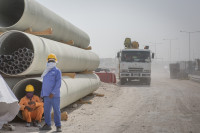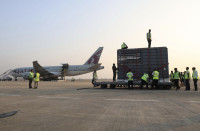Valley
Aid accountability
Nepal lacks internal capacity to spend development aid on time; policy analysts should closely follow how MCC grant is spent
Pawan Roy & Saurav Raj Pant
Nepal became eligible to receive a $500 million grant from Millennium Challenge Corporation (MCC) by passing 16 of the 20 indicators in its scorecard for 2017. MCC is a US government agency working to reduce poverty through economic growth by providing time-limited grants and assistance to selected developing countries as per their scorecard. Performance is assessed in three policy categories: Ruling Justly, Investing in People and Encouraging Economic Freedom. The grant will be spent on the Electricity Transmission Project and the Road Maintenance Project.
A 300-km-long 400 kV transmission line will be built from Lapsephedi-Galchi, Galchi-Damauli, Galchi-Hetauda and Damauli-Sunwal. The money will also be used to upgrade the Hetauda-Bhimphedi, Dharan-Basantpur, Kadmaha-Gaighat and Amelia-Dhankhola roads. The land acquisition process in Nepal takes more than 15 months, which makes it doubtful if the project will be started on time. Moreover, the efficiency of Nepal’s bureaucracy, which has a reputation of being ‘lazy and fragile’, is key to successfully spending the money.
Time-bound
Nepal’s low rate of public expenditure makes one doubt whether the project will be completed on time. In 2016, Nepal struggled to meet its expenditure target of 50 percent, and spending only amounted to Rs1,048.9 billion or 28 percent of the budget. In 2016, the Asian Development Bank (ADB) expressed dissatisfaction at the slowness with which the Nepal government was awarding contracts.
In the third quarter of 2016, the Nepal government was able to award contracts worth $231.7 million against the ADB’s expectation of $311.6 million. In 2017, the disbursement of funds improved greatly with the government giving out $221 million, achieving 89.5 percent of the target. The rate of progress has been slow in important projects like energy, transport and the Earth Emergency Assistance Project (EEAP). Energy and transportation projects in Nepal have a history of slow performance due to the involvement of the development mafia which is not willing to go for e-bidding.
The infrastructure projects being implemented with Indian aid are the 900 MW Upper Karnali, 900 MW Arun III and 5,600 MW Pancheshwar Multipurpose Project. The Muzaffarpur-Dhalkebar cross-border transmission line has been completed and the Kathmandu Valley has been getting 40 MW of electricity through the Muzaffarpur-Dhalkebar-Khimti power line. Among the notable Chinese-aided energy projects, the two governments have agreed to build the 1,200 MW Budhi Gandaki Hydroelectric Project while the Upper Marshyangdi A and Upper Madi projects are in the final stages of completion.
There are many projects being implemented with Indian, Chinese and ADB assistance, but due to Nepal’s weak internal capacity, various schemes are lying in limbo. Nepal lacks internal capacity to spend development aid on time. Therefore, all policy analysts should closely follow how the MCC grant is being spent. Aid effectiveness is a much debated topic in Nepal, and making effective use of aid has emerged as the most difficult task for the government. For any grant to succeed, the important indicators are transparency, accountability, effectiveness and partnership. Nepal is deficient in all these indicators.
Wise utilisation
Nepal is the first South Asian country to receive the MCC grant, and it is not like the other grants it has been receiving. Nepal qualified for this grant by passing the indicators in the MCC’s scorecard. So this is a purely data-driven grant, which means that signing the agreement will not guarantee that Nepal will receive the grant for five years. In order to keep the grant coming, the Nepal government has to ensure that there is good governance, democracy, transparency and political stability every year for five years. It has also been mentioned that the suppliers and contractors involved in carrying out the projects will be selected through a rigorous global application process.
History shows that effective implementation of aid has helped countries to rebuild from ruin. For example, the Marshall Plan helped Western European countries, especially the UK (which received 26 percent of the total funding), France (18 percent) and West Germany (11 percent), to rise out of the rubble of World War II. Germany and Japan are the two greatest examples of rapid post-war recovery and emergence as major global economic powers. This means that aid money can be greatly beneficial if utilised wisely.
The MCC grant is currently being managed by the autonomous Office of Millennium Challenge Nepal under the Ministry of Finance which has a board and eight-member core committee. Since this grant involves the Nepal and US governments, it has a multi-sectoral oversight mechanism. This guarantees effective implementation of the money, transparency, accountability and ownership. This is a massive grant in the history of Nepal, and if it is spent on time, it will send a good message to other development projects that are currently in limbo. Therefore, every concerned stakeholder should make it a priority to be responsible and work by adhering to the strict timeline of the grant. With the recent completion of parliamentary and provincial elections, Nepal should have a stable government and the MCC grant can be expected to be spent efficiently.
Roy is an international relations student at Tribhuvan University; Pant is a development consultant




 17.12°C Kathmandu
17.12°C Kathmandu










%20(1).jpg&w=300&height=200)

